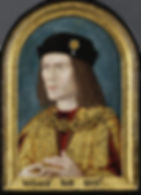The Reburial of Richard III
- Marija Istrefi
- Mar 18
- 3 min read
Updated: May 10
The mystery of King Richard III’s burial had captivated historians, archaeologists, and enthusiasts for centuries. After his death at the Battle of Bosworth in 1485, Richard III’s body was taken to Leicester and publicly displayed before being buried beneath the Grey Friars Church. However, with the dissolution of the monasteries under Henry VIII, the church was demolished, and Richard’s resting place became lost to history.
Over the years, various rumours and myths clouded the truth. The most prominent of these was perpetuated by historian John Speed in 1611, who mistakenly claimed that Richard’s body had been removed from the church ruins and thrown into the nearby Bow Bridge by an angry mob. This tale gained credibility over time and misled generations of historians, while a skeleton found in the river in the 19th century further cemented this false narrative.
In the early 2000s, a team led by Philippa Langley and the Richard III Society initiated a quest to locate the lost king’s grave. Through extensive historical research, they uncovered the error in John Speed’s account. His confusion stemmed from visiting the wrong site, the Blackfriars Church instead of Grey Friars. The team realised that Speed’s map had placed Grey Friars Church in the wrong location, mistakenly marking it where Blackfriars Church had stood.
This revelation redirected their attention to the true location of Richard’s burial, which lay beneath what was now a mundane car park in Leicester. However, they faced another challenge: the original Grey Friars site had been covered by various buildings over the centuries, and only limited portions of the area were accessible. Budget constraints meant they could only dig up a small section of the car park, so the excavation had to be conducted with extreme precision.
On 25th August 2012, precisely 527 years after Richard III’s burial, the archaeological team began their dig. They decided to dig three trenches, hoping to intersect the location of the church. The strategy paid off almost immediately. In a moment of striking coincidence, just six hours into the excavation, they unearthed a skeleton buried mere metres away from a parking space marked with the letter "R", an oddly appropriate sign for Richard.

The Excavation and Identification
The skeletal remains displayed clear evidence of battle injuries, including significant trauma to the skull. The spine also exhibited pronounced curvature, which corresponded with historical descriptions of Richard III as having one shoulder higher than the other. This discovery alone was compelling, but further scientific analysis was necessary to establish the identity beyond doubt.
The team employed carbon dating to estimate the age of the remains. While initial results suggested the skeleton was a few decades older than Richard’s death, adjustments accounting for a high-protein, seafood-rich diet, consistent with a medieval aristocratic lifestyle, confirmed the body was indeed from the correct period.
Even more definitively, mitochondrial DNA testing was conducted. This type of DNA is passed down the maternal line, making it ideal for establishing lineage over multiple generations. Researchers traced Richard’s maternal lineage to two living descendants: Michael Ibsen, a cabinet maker from Canada, and Wendy Duldig.
However, to ensure accuracy and rule out the possibility of false positive results due to potential marriage complications within the family tree, the researchers had to compare the DNA of both individuals. By confirming that Michael Ibsen and Wendy Duldig were indeed related through the same maternal line, the researchers were able to validate the DNA results with greater certainty. The match was conclusive, confirming that the remains indeed belonged to Richard III.
The Funeral
The discovery of Richard III’s body was a monumental moment not only for historians but also for the general public. Recognising the significance of the find, plans were made for a formal reburial that would honour Richard’s legacy and provide him with the dignified resting place he was denied at the time of his death.
On 22nd March 2015, Richard III’s remains were placed in a coffin constructed by his relative, Michael Ibsen. The coffin was transported through Leicester in a ceremonial procession, witnessed by thousands of people paying their respects. His reburial took place at Leicester Cathedral on 26th March 2015, in a solemn and respectful ceremony attended by dignitaries, members of the public, and representatives of the monarchy.
A particularly remarkable aspect of the funeral was that it was the first Catholic English king’s burial in centuries, with efforts made to ensure the ceremony was authentic to Richard’s time. The service included prayers and readings from religious figures, acknowledging both Richard’s status as a monarch and the centuries of speculation surrounding his death and burial.
